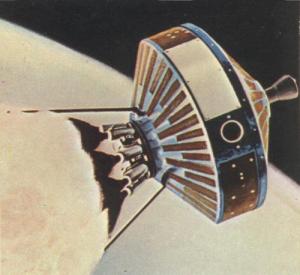|
|
|
|
..
of the probe and the camera eye is visible on the waist. President Eisenhower approved the first american lunar program, partly derived from JPL's Project Red Socks, on March 27, 1958. The plan envisaged five ARPA (Advanced Research Project Agency) coordinated missions: three managed by USAF (United States Air Force) and two managed by the US Army. In 1958, it must be remembered, almost all of the space programs were managed by the military: NASA (National Aeronautic and Space Administration) was formed only on October 1 of that year on the structure of the far more modest NACA (National Advisory Commitee for Aeronautics). The plan resulted too ambitious from the start: the Americans had no experience of interplanetary navigation, and their launchers left much to be desired. In spite of this, the USAF was planning of putting a satellite around the Moon right from the first attempt! The USAF probe was built inside two squat glass fiber
cones joined at their base by a cylinder and topped by a separable cluster
of eight small vernier rockets and by a solid propellant, 13.3 kN thrust
rocket based on the Falcon air to air missile. The Falcon rocket was to
be used to slow the probe until it entered lunar orbit.
The scientific instruments weighted 18 kg and included: a simple camera in which an oscillating mirror scanned the Moon sending its image to an infrared lead sulfide photodiod, a radiation counter, a simple search coil magnetometer and a microphone to register the impact of micrometeorites. The small probe was covered by a series of removable black and white stripes to control its temperature and was sterilized by exposing it to ultraviolet rays. The launcher was to be a Thor-Able, made by joining
a medium range Thor missile the second (Able) stage of the ill-fated Vanguard
rocket and a solid propellant third stage. The launcher could send 39 kg
to the Moon.
The fourth Thor-Able was mated to pad 17A of Cape Canaveral
in the summer and the first lunar shot in history was made four minutes
late at 12.18 GMT on August 17, 1958 before a small number of journalists.
The probe did not receive a name and is indicated as Pioneer-0 or Able-1. The launch attracted much interest and was the first aired on TV by NBC. As there was still no live feed at the time, the launch was shot on a film which was then flown to the West Coast, taped and finally aired. Before the launch of the second probe, the whole program was transferred to NASA, with the USAF and the ARmy acting as simple consultants. It was NASA who gave the probes the name Pioneer, series which eventually counted eighteen planetary probes up to the end of the Seventies and notably Pioneer-10, the first probe to fly-by Jupiter and to leave the Solar System. The new agency decided not to waste any time the first
NASA launch, on October 11, 1958, just ten days after its foundation, was
that of a lunar probe: Pioneer-1 (or Able-2): the second USAF orbiter whose
launcher, just two days before lift of, was missed by a few tens of meters
by the debris of another missile which blew up in flight.
Pioneer-1 flew up to 113.854 km from Earth, less than a third of the distance of the Moon and fell back, disintegrating in the atmosphere after a 43 hours, 17 seconds flight. The mission was a failure, but the probe transmitted interesting data on the Van Allen belts, measuring their extension, on micrometeorites. registering only 0.0052 impacts per second per square meter of sensor. Using the small vehicle as a repeater, the antennae of Jordell Bank, England and Milestone Hill, Massachusetts, were briefly linked, demonstrating the transoceanic communications that are now a thing of every day (NOTE: this story is not confirmed by the detailed account on Jordell Bank space tracking activites by Sven Grahn). Pioneer-1 was also the first space launch to be aired live on TV. The second NASA lunar probe was launched one day late on November 8, 1958. Pioneer-2, or Able-3, was very similar to the preceding probes, but it had some important modifications: the NOTS (Naval Ordnance Test Station) infrared camera was replaced by a lighter, visible camera built by STL (Space Technology Laboratories) that offered also a better resolution. Its place was moved from the waist to the lower cone. A cosmic ray counter was added and the batteries were replaced altogether, after they failed on Pioneer-1. For this probe another transoceanic communication attempt was scheduled. The launcher received some modifications to the staging system and a new system of integrating accelerometers to shut off the engines at the exact desired speed. All these precautions were useless because the third, solid, stage did not ignite at all. Pioneer-2 burned over Africa after a 45 minutes parabolic flight during which it reached 1.600 km into space. Bibliography
|
|
| FAIR USE NOTICE: This page contains copyrighted material the use of which has not been specifically authorized by the copyright owner. Pegasus Research Consortium distributes this material without profit to those who have expressed a prior interest in receiving the included information for research and educational purposes. We believe this constitutes a fair use of any such copyrighted material as provided for in 17 U.S.C § 107. If you wish to use copyrighted material from this site for purposes of your own that go beyond fair use, you must obtain permission from the copyright owner. | |
|
|

